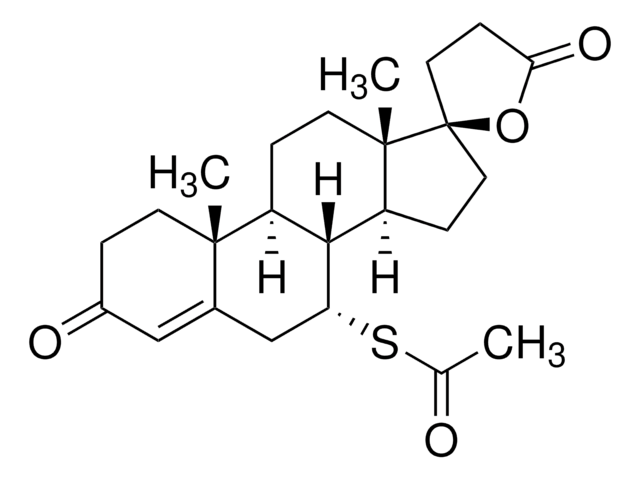추천 제품
분석
≥98% (HPLC)
양식
powder
색상
white to beige
solubility
DMSO: 2 mg/mL, clear
저장 온도
2-8°C
SMILES string
O=C(N1CCCCC1)OC2=NSN=C2N3CCCCC3
InChI key
PNYYVHOTXOEBEV-UHFFFAOYSA-N
애플리케이션
Lalistat 2 has been used as a lysosomal acid lipase (LAL) inhibitor to study its effects on hypoxia-inducible factor (HIF) in mice. It has also been used as a LAL inhibitor to study LAL activity on dried blood spot cards.
생화학적/생리학적 작용
Lalistat-2 is a potent and specific competitive inhibitor of the lysosomal acid lipase (LAL/Lipa). Lalistat-2 affects lipid droplets morphology and localization.
potent and specific competitive inhibitor of the lysosomal acid lipase (LAL/Lipa).
Storage Class Code
11 - Combustible Solids
WGK
WGK 3
Flash Point (°F)
Not applicable
Flash Point (°C)
Not applicable
가장 최신 버전 중 하나를 선택하세요:
이미 열람한 고객
Maidina Tuohetahuntila et al.
The Journal of biological chemistry, 292(30), 12436-12448 (2017-06-16)
Activation of hepatic stellate cells (HSCs) is a critical step in the development of liver fibrosis. During activation, HSCs lose their lipid droplets (LDs) containing triacylglycerols (TAGs), cholesteryl esters, and retinyl esters (REs). We previously provided evidence for the presence
Chiara Pavanello et al.
Pharmacological research, 147, 104362-104362 (2019-07-23)
Lysosomal acid lipase (LAL) is responsible for the hydrolysis of cholesteryl esters (CE) and triglycerides (TG) within the lysosomes; generated cholesterol and free fatty acids (FFA) are released in the cytosol where they can regulate their own synthesis and metabolism.
Stefanie Schlager et al.
Oncotarget, 8(25), 40037-40051 (2017-04-14)
Degradation of lysosomal lipids requires lysosomal acid lipase (LAL), the only intracellular lipase known to be active at acidic pH. We found LAL to be expressed in murine immune cells with highest mRNA expression in macrophages and neutrophils. Furthermore, we
Anton I Rosenbaum et al.
Journal of medicinal chemistry, 53(14), 5281-5289 (2010-06-19)
Niemann-Pick type C (NPC) disease is a lysosomal storage disorder characterized at the cellular level by abnormal accumulation of cholesterol and other lipids in lysosomal storage organelles. Lysosomal acid lipase (LAL) has been recently identified as a potential therapeutic target
Xinlei Li et al.
Frontiers in cell and developmental biology, 9, 640667-640667 (2021-04-06)
Extracellular vesicles (EVs) are membrane-limited nanoparticles that are liberated by cells and contain a complex molecular payload comprising proteins, microRNA, RNAs, and lipids. EVs may be taken up by other cells resulting in their phenotypic or functional reprogramming. In the
자사의 과학자팀은 생명 과학, 재료 과학, 화학 합성, 크로마토그래피, 분석 및 기타 많은 영역을 포함한 모든 과학 분야에 경험이 있습니다..
고객지원팀으로 연락바랍니다.









